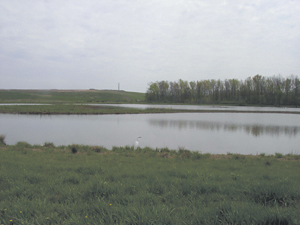DID YOU KNOW? HEALTHY WETLANDS DEVOUR MOSQUITOES
 Surprise!
Surprise!
Contrary to popular belief, healthy, functioning wetlands can actually reduce mosquito populations.
But Everybody Says . . .
Mosquito control programs commonly recommend that wet-lands be drained in order to control mosquitoes. This is because mosquitoes require standing water to breed, and if there is no standing water, there will be no mosquitoes. Quite true. However, mosquitoes have a very short life cycle (from 4 days to a month), and their eggs can remain dormant for more than a year, hatching when flooded with water. Therefore, even after a wetland has been drained, it may still hold enough water after a rain to breed mosquitoes. The drained area may actually produce more mosquitoes than it did when it was a wetland!
Healthy Wetlands Versus Wet Areas and Standing Water
A healthy wetland provides habitat for many unique animals including natural enemies of mosquitoes. These natural predators keep the mosquito population low. Mosquitoes become a problem, however, in areas that have standing water, yet do not support the beneficial animals that feed on mosquitoes. Most any kind of wet area or standing water makes a good breeding site for mosquitoes: old tires, cans, and other containers that collect rainfall; even hollow logs that hold water, and low spots in the ground where water pools. And because these types of places do not provide good homes for those beneficial insects and other kinds of wildlife that feed on mosquitoes, the mosquitoes quickly reproduce out of control.
The Balance of Nature
Mosquito populations are held in check in healthy wetlands. Certain birds, frogs, fish, and insects live in these wetlands and feed on mosquito larvae and/or adults.
The following insects are natural enemies of mosquitoes:
* Dragonflies
* Damselflies
* Water Striders
* Backswimmers
* Predacious Diving Beetles
But these insects need proper habitat (healthy wetlands) to survive. You won’t find them in the typical areas where mosquitoes thrive – small spots of open, standing water and other wet areas where mosquitoes can become thick as fog.
Reduce Mosquito Populations Restore A Wetland
Wetland restoration decreases mosquito populations in two ways: by providing proper habitat for the natural enemies of mosquitoes, and by preventing or reducing flooding (in areas that aren’t normally wet and thus support mosquitoes but not their predators). When the Essex County Mosquito Control Project restored a 1,500-acre wetland in Massachusetts, the mosquito population dropped by 90 percent. The experts there know that wetland restoration is synonymous with genuine mosquito control (Audubon Magazine, November-December 1996). And in Indiana, the most serious mosquito problems tend to occur in flood-waters and woodland pools. So by restoring healthy wetlands, we really can do ourselves and all Hoosiers a big favor!
Make a Lasting Improvement
If you own or manage drained wetlands, you can expect “blooms” of mosquitoes after every rain. If you’re tired of donating blood, consider restoring or creating a healthy wetlands. Within days, natural predators of mosquitoes will begin to return. Not only will you be reducing the mosquito population, you’ll also be creating excellent wildlife habitat, reducing the likelihood of flooding on adjacent ground, improving water quality, and possibly other benefits as well!
Quick Fix
If you’ve determined that you really need a “quick fix” for your mosquito problem, at least try to use the more environmentally friendly methods.
Here are two:
* Bacillus thuringiensis israelensis (Bti) is a bacterium that can be used in almost any aquatic habitat with no restrictions. It is fast acting and quickly biodegrades. The timing of its application is critical to its effectiveness.
* S-methoprene is a synthetic mimic of an insect hormone. It is safe for workers and degrades into simpler compounds.
Remember that these methods are not permanent or long lasting, but must be repeated for effective control.
Smart Economics
It pays to control mosquitoes in an environmentally friendly way. New Jersey has been controlling mosquitoes “the natural way” by using a technique called Open Marsh Water Management (OMWM). This technique controls mosquito larvae by eliminating breeding depressions (low areas where water pools) and by increasing natural enemies of mosquitoes. Insecticides are not used. The Cape May County Mosquito Extermination Commission reported spending approximately$16,000 to implement the OMWM method on a marsh in 1969. This was a one-time expense because 25 years later, the marsh still had not needed maintenance, cleaning, or pesticides. The Commission estimated that the cost to use traditional insecticide methods (repeatedly treating the area with chemicals) over the same period would have been $685,000. OMWM resulted in a savings of $669,000 – over 97 percent! (www.umaa.org/ecomosco.htm).
In a separate economic study, The Commission compared a range of costs for OMWM with the cost of traditional larvicide methods for the estimated 20-year life of the OMWM method. The cost ranges for OMWM method. The cost ranges for OMWM were $5 to $63 per acre. The cost of using larvicide was $286 per acre. OMWM resulted in a savings of from $222 to $280 per acre or 78 to 98 percent! (The Economics of Marsh Water Management – A New Jersey View, Proceedings of the 63rd Annual Meeting, NJ Mosquito Extermination Association.)
The Little River Wetland Project currently has 2 restoration projects underway. Photo above is of the Eagle Marsh project located between Fox Island Park and Engle Road. For more information contact Paul McAfee at 478-2515 or lriver3@juno.com.
- What To Know About Mosquito Season - July 19, 2024
- Local Worship & Events: July 19 Update - July 19, 2024
- Allen County Bar Foundation Announces Scholarship Winners - July 19, 2024


